Merciless arboretum review #2: The Morris
I think I did one of these a few years ago for the Cylburn in Baltimore. Well, it's better than that, thankfully, but still rough around the edges in places. For better or worse you're talking about a very competitive market in public gardens. Longwood and Chanticleer are different, but both in a league of their own when it comes to be being impressively maintained and creative public gardens.
OK, here's the visitor's center, in the quintessential Pennsylvanian style. I was there for a rhododendron sale, so I got free admission.

an Abies holophylla:
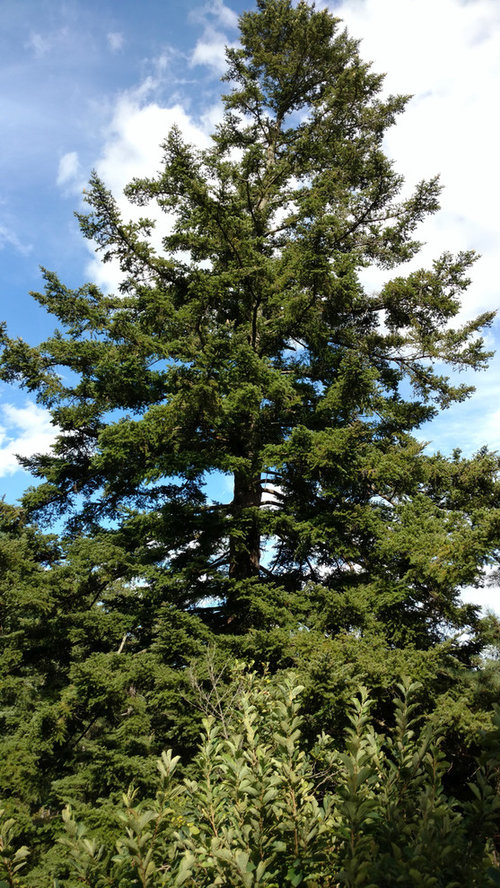
I couldn't even got close to one rare looking pine, because the trunk was surrounded by this. Even assuming it had a tag - many plants seemed to be missing them.

This is the biggest paperbark maple I've ever seen, but I'm sure there are bigger ones out there. Impressive though. I should have taken a picture from another angle to show how tall it really was, but I'd say at least 45'.

I was looking for the Pinus hybrid 'Mercury' named after a statue in this garden. I found the statue, but couldn't locate the pine. Maybe this is it, but I didn't see a label or plaque.

A typical garden scene:

A Cunninghamia next to - I think - a Sequoiadendron this garden is particularly known for. Uuummm, yeah. I'll take the Cunninghamia! I'm not sure that oak needed to planted there.

Finally, what looked like a Picea orientalis 'Skylands'. If it is, it's the biggest I've seen.

Main pros:
nice collection
seems well run, although they need some vending machines that take credit cards...or have the cafe not close by 3pm on a weekend afternoon
cons:
need better labeling
need to banish poison ivy from the garden
a bit shabby in parts but I could be more forgiving if I hadn't seen the poison ivy
Longwood and Chanticleer are still the must-see gardens in SE PA. This might appeal more to tree and conifer lovers, specifically, than Chanticleer. But Longwood has the overall edge in the big tree department. The Tyler and Jenkins Arboreta are best if you want to see elepidote rhododendrons in spring.
Comments (33)
Toronado3800 Zone 6 St Louis
7 years agoThanks for the write up. Interesting, I was just talking about paperbark maples amd max size.
davidrt28 (zone 7) thanked Toronado3800 Zone 6 St Louisdavidrt28 (zone 7)
Original Author7 years agolast modified: 7 years agoThanks Toronado. I was very impressed by that tree although it's a shame they let it develop the split trunk. Looks like an accident waiting to happen if a severe thunderstorm or microburst hits the garden...although of course at a certain point, it will just be brought down regardless. Maybe split leaders are more harmful to conifers because of snow loads pulling them apart. That's what happened to a huge Juniperus that used to be in my garden.
Related Professionals
Fort Lee Landscape Architects & Landscape Designers · Simi Valley Landscape Architects & Landscape Designers · Arlington Landscape Contractors · Cincinnati Landscape Contractors · Cupertino Landscape Contractors · New Providence Landscape Contractors · Newnan Landscape Contractors · The Villages Landscape Contractors · Waltham Landscape Contractors · Fairfax Siding & Exteriors · Lebanon Siding & Exteriors · Coronado Decks, Patios & Outdoor Enclosures · Dedham Decks, Patios & Outdoor Enclosures · Draper Decks, Patios & Outdoor Enclosures · Richmond Decks, Patios & Outdoor Enclosuresindianagardengirl
7 years agoThe Morris was the first place I saw a grove of dawn redwoods, and inspired me to have to get one. So, if that's part of what arboreta are supposed to do, it's a win. :-)
I'm with you 100% on the cons, especially regarding labeling, and the vending, sheesh! If money is an issue (and whenever is it not) then figure out this stuff!
davidrt28 (zone 7) thanked indianagardengirl- davidrt28 (zone 7) thanked gardener365
sam_md
7 years agolast modified: 7 years agoNice Japanese shrub. It's claim to fame is several weeks of fall color. The habit is great, no need to prune or touch it. For a variety of reasons this one will always be relegated to collectors and botanic gardens. This particular one is a Morris Arboretum introduction. Can you name it?
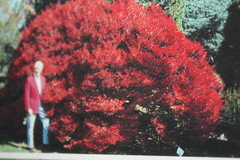
Embothrium
7 years agolast modified: 7 years agoScattershot labeling has been said to be a general condition, with the history of comprehensive labeling of the Seattle arboretum - probably due directly to the involvement of Brian O. Mulligan - we long enjoyed here being exceptional. Consistent with this when I went to Kew - "the world's greatest garden" - in the 1990s labeling was almost incidental, as it was also at Westonbirt. Wisley, however may have been better, and Hillier may have been pretty good - I don't remember now.
Even at the Seattle facility in more recent years there was a graduate student who went through the Pinetum and replaced long present, correct labels with wrong ones - I don't know if this ever got straightened out - and then after that it was decided to not put the names of the plants (just the numbers) on the tags, so people wouldn't steal them (they see a plant they like, take its tag with them so they have the name). So newer plantings may have no information attached that is of any use to anyone other than staff - and members of the public who know how to read the accession dates.
They also used to have it that one could go to the tiny office and look plantings up in their files, but that ended when the compound was redesigned and expanded - at which time the curatorial offices were separated from the new visitor center and put "out back". There are no signs directing the public back to this building and when those of us who are interested enough to end up back there so appear the atmosphere created is one of interruption and invasion.
>Can you name it?<
View is from too far away except when I click to enlarge the branching looks like Enkianthus perulatus
davidrt28 (zone 7)
Original Author7 years agolast modified: 7 years agoEmbo: FWIW, every single plant you'd want to know about is labeled at Longwood; but of course that's Longwood with their ridiculous half billion or more endowment. I think if a single annual rye grass seedling is found in the wrong bed there, someone gets a stern talking to. But the same is generally true at Chanticleer, and labels at the Tyler, Jenkins, and Udel are good enough to "get the job done". I've almost never had want of knowing what something was at those places. (nor at Kew; I've been there 3 times) So compared to other local gardens I've explored, the problem is a significant drawback of the Morris. I was particularly peeved I couldn't find the Pinus 'Mercury' since it was actually named after a feature in the garden!
Anyhow...agree with you that vandalism is a problem. (even by graduate students, apparently - I wonder what his agenda was!) The curator at the private Hunnewell Arboretum in MA - not the university garden across the lake - told me that over the course of the 50s to the 80s, essentially all of the collections labels were destroyed or moved. This being for over 500 plants. This made me jokingly refer to the 50s through 80s as the "golden age of American vandalism." I actually don't think most of today's kids would bother with doing something so inane. They'd be more interesting in, I dunno, hacking their peers' Snapchat accounts or whatnot.
Embothrium
7 years agolast modified: 7 years agoMaybe they stepped things up at Kew since I was there - labels were definitely here and there at that time. To this end my traveling companion and I had to help a local couple with a prominently displayed and located Oemleria cerasiformis - native to our region - they were intrigued by because it was in flower.
And had no labeling or signage whatsoever.
I also missed trees I knew were there in part because it was March and we didn't cover the entire facility. So even if we did walk right by a tree I wanted to see I may not have been able to tell if an unlabeled trunk with bare branches high over head was the particular one or not.
A specific objective on that trip was trying to match still locally prevalent Lawson cypress cultivars with those in British collections. A minimum of this was accomplished due in large part to labels often being absent.
Also we didn't make it to Bedgebury, which was probably the main place to go for this (the other person wanted to shop for hellebores etc.).
sam_md
7 years agoMy pic of the red shrub is indeed Enkianthus perulatus, Nov 1998 @ Morris Arboretum. Here is closeup of my plant today.
cv name is 'J.L. Pennock' Now I need davidrt28 to assure me that this plant is still there and looking great.
Sara Malone Zone 9b
7 years agoI would think (hope?) that now that people can take photos of labels with ease, they should be safer from vandalism.
indianagardengirl
7 years agoDavid, please forgive my ignorance, but evidently you are a rhodie kind of guy? I've been lucky enough to go to Winterthur in spring a couple of times, and was blown away by the woods full of these. Nothing like this near me, and it was breathtaking...
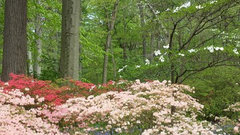
davidrt28 (zone 7)
Original Author7 years agolast modified: 7 years agoI do need to go to Winterthur. Maybe next spring. However as far as I know it is mostly known for its azaleas. Which is fine - but they are far more common than elepidote rhododendrons. Which for whatever reason many botanic gardens in the mid-Atlantic don't like to meddle with. Presumably for their "difficult" reputation. There are a few at Longwood, but it's basically a yawn fest compared to their other collections like conifers or azaleas. I can't think of ever seeing a memorable rhododendron at any municipal or public garden in the DC area, besides the little known McCrillis. But memorable to me would mean, anything other than the 'ironclad' sold by the millions at big box stores. Perhaps various places had 'Roseum Elegans' etc. in bloom and I would have walked right past them without caring.
The best places on the east coast, NYC & south to see them are: various places on Long Island like Planting Fields Arboretum. The Rarefind display garden although that's not what it was. There's some other garden in NJ known for them, a former estate, but the name escapes me at the moment. The Tyler and Jenkins as I mentioned. The Scott Arboretum to some degree, although they seem much stronger in hollies. It's not clear to me if the so-called 'Wister Residence' is somehow a separate collection...I need to check on that. They supposedly have a lot of Dexter and Gable hybrids. Finally McCrillis, though it's a small collection. The Tyler is probably the best, and one of the only places you can see 10'+ rhodies that are actually interesting and comparatively exotic looking, ones like 'Mt. Siga'. I don't know enough about areas north of NYC to comment. The Heritage Plantation in Sandwich, MA, has many of the original Dexter plants, and fortunately is maintaining them. Smith has a small Mt. Siga: https://www.smith.edu/gardens/bgilib/web/imageFrameset.php?cat=3&latin_name=Rhododendron+vernicosum+%27Mt.+Siga%27
So compared to the overall high # of gardens along the NYC to DC corridor, not very many places to see the big leaf rhodies. (In this context I just mean elepidote, not the huge leaf Himalayan ones)
Sara Malone Zone 9b
7 years agoA great place for big leaf rhodies is the Mendocino Coast Botanical Gardens. They have a good rhododendron collection overall and it's a lovely site.
Dave in NoVA • N. Virginia • zone 7A
7 years agolast modified: 7 years agoI feel fortunate that we have several nice arboretums/public gardens in our area. Now, if I only had the time to visit them!
Ranked in order of quality and variety:
#1 US Arboretum (DC) best bang for the buck (but it's free). It would take me a full day to see everything. My favorite is the Asian Valley...plants from Asia -- MANY wonderful broadleaved evergreens, camellias. The holly collection is quite good.
#2 Brookside Gardens (Kensington, MD) very well maintained with some unusual plants. A nice place to stroll.
#3 US Botanical Gardens, National Garden, Bartholdi Park (DC) busy place, hard to park, but worth the visit
#4 Greenspring Gardens (Alexandria/Annandale, VA) a gem in the burbs
#5 McCrillis Gardens (Bethesda, MD) an old estate willed to the County. Many things not labeled, some very old specimens of unusual plants. Lots of broadleaved evergreens.
#6 Meadowlark Gardens (Vienna, VA) this place is huge, but has uninspired plantings, deer problems.
#7 Dumbarton Oaks (Georgetown, DC) Small and compact, old, and nothing unusual
#8 River Farm (Alexandria, VA) -- home of the Amer. Hort. Society. Large, but not much out of the ordinary. Nice location right on the Potomac River.
I'm sure there are more, but I haven't visited them all.
davidrt28 (zone 7)
Original Author7 years agolast modified: 7 years agoDave,
That's a good run down of DC area gardens...I concur with your rankings. Though Dumbarton Oaks is definitely better than Meadowlark! I'd probably put Meadowlark last on the list, myself. I'm sure you are also aware of the Virginia State Arboretum, about an hour west of DC. Many fine conifers there, especially.
About 10 years ago McCrillis had a few unusual rhodies, but I wonder whether the majority of them survived 2010, 2011 & 2012. Probably the worst string of hot summers since the 1930s. I haven't been there since 2008 or so.
Sara, you might be amused by my reports on visiting Norcal gardens in April. Feel free to comment here and not bump those...unless you want to for some reason.
http://forums2.gardenweb.com/discussions/3828976/norcal-field-trip-report-pt-1-maybe
http://forums.gardenweb.com/discussions/3876249/as-requested-a-few-more-norcal-pictures
cecily
7 years agoNorfolk has a large collection of azaleas and rhodies that were planted by the CCC in the 1930's and haven't been pruned much since. Probably common varieties (unlabeled) but DANG each plant is the size of an SUV and there are hundreds of them..
davidrt28 (zone 7)
Original Author7 years agolast modified: 7 years agoAre you sure they are elepidote rhododendrons? I myself feel like I hardly ever see them down there. Though in fairness it could partly be because there are more BLEs planted period - which is a good thing - and they get somewhat lost in the mix.
For example the Norfolk Botanic Garden inventory claims to have a lot of elepidotes, but in being there 2 times in the past 10 years, I don't remember noticing any! Some were bred specifically for local conditions by a woman named Sandra McDonald IIRC. Using species like R. hyperythrum much as Thornton did in south Louisiana. I have relatives down there and might make a quick trip down there in spring to check them out. Of course a handful of enthusiasts might manage to grow them using techniques like raised beds.
FWIW I know full-time landscapers even in DC who say they won't mess around with planting elepidotes, even the "ironclads". Likewise my SE VA relatives say they are uncommon down there...so it's not just my perception. They are really way more common from Baltimore to points north.
davidrt28 (zone 7)
Original Author7 years agolast modified: 7 years agocecily, can you give me a hint on where to find them? Are they in the Ghent neighborhood? My uncle lived in that area when I was kid - I mean really a kid, like 4 or 5, and I do have the vaguest memory of just - you know, green stuff LOL. What a 4 or 5 year old kid perceives: a lot of plants are around here. No specifics! I haven't been back to that area since then, but it's not like I couldn't swing by on my next trip.
davidrt28 (zone 7)
Original Author7 years agoOne more pic - any thought on what this could be? Maybe Japanese Tree Lilac?
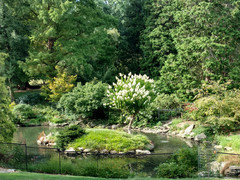
maackia
7 years agoI have not seen all of the US, but IMO the Philly area is the best metro region for horticultural pursuits that I have been to. I thoroughly enjoyed my visit to the Morris. The entire Brandywine Valley is spectacular. Longwood is an amazing place and definitely worth the admission, but my spouse and I agreed that it was almost over-the-top with all the annual plantings and overt commercialization. Actually, it reminded me a bit of Butchart Gardens in Victoria, BC, in that respect. It's amazing what you can do with an unlimited budget and an army of gardeners. The Victoria-Vancouver area is right up there with Philly for plant lovers.
As an FYI, if you visit Scott Arboretum, which is essentially the campus of Swarthmore College, take a short jaunt down the road to Haverford College, which has several Pennsylvania champion trees. Oh, and don't forget old John Bartrams place. Not the most scenic of locations, but worth visiting for historical purposes. Carl Linnaeus called Bartram the "greatest natural botanist in the world."
davidrt28 (zone 7) thanked maackiacecily
7 years agoI was referring to NBG, sorry for not making that clear. The area around mirror Lake is all azaleas but the enchanted forest has numerous rhodies, unfortunately none are labeled.
The tree in the above photo might be a hydrangea paniculata (guess based on the size & length of the trusses). In the photo, it looks like its growing in the water?
davidrt28 (zone 7) thanked cecilygardener365
7 years agoHydrangea paniculata is what I thought, too. The bark is right for H.p. as-well.
Dax
davidrt28 (zone 7) thanked gardener365indianagardengirl
7 years agoAgree with maackia on the Brandywine valley. Longwood, Winterthur, Mt Cuba, Chanticleer, Morris, on and on and on...
Of the list above, Winterthur is tops for me. Everyone should see Longwood if they can, but Winterthur is more to my style and the one I would go back to.
davidrt28 (zone 7) thanked indianagardengirlSara Malone Zone 9b
7 years agoThanks David, just read your No Ca write-ups and added a few comments - sounds like it was a fun trip! I'm originally from Princeton NJ, my parents lived in Newark DE for a few years and my sister lives in suburban DC (Annandale) so I have spent many hours in some of the gardens you name. Went to Winterthur a lot because it was so close to my parents, and even though I am a tree gal, had to admit that the bluebell hill was gorgeous - have never seen so many bulbs in a woodland setting before. The trees there are great. Longwood, while obviously worth seeing, was not my cup of tea (and don't get me started on Butchart). I haven't been to Chanticleer or the Morris and next time I'm in that area will have to make sure to include them (maybe worth a trip just for that!) Have you been to the Grounds for Sculpture in NJ? That one is fun, too, and mostly for the sculpture but they have some great trees. I guess you didn't go to Filoli when you were here, either? An odd spot in this century given our drought and our changing aesthetic here, but they have the two biggest Camperdown elms that I have ever seen (one of which a disgruntled employee tried to kill by girdling) and they are magnificent. These are fun postings, thank you.
davidrt28 (zone 7)
Original Author7 years agoI'm not into sculpture, particularly, but I've seen pictures of Grounds for Sculpture and it looks amazing. I mean to go at some point.
I wanted to see Filoli but just didn't have time on this trip. Or, I could have, but it would have really made me really rushed. But a friend who has a large garden in Berkeley (yes, actually large, they made a very wise real estate investment years ago) told me I would find it the least interesting garden in the Bay Area, because it's mostly trying to be an English/European stately home formal garden and not a collection of rare subtropical plants.
Interesting you are from the Delaware Valley, the female half of the
owners of Digging Dog, at least, told me she was from the Philly area.Embothrium
7 years agolast modified: 7 years agoPictures of Filoli are fairly easily come across, they do all this dumb shearing of nearly everything woody. But - if these are still present - they also do have what are probably the biggest Nothofagus solanderi var. cliffortioides in North America, one of which was 77 1/2 ft. high by 9 ft. 5 in. around in 1994.
davidrt28 (zone 7) thanked Embothriumdavidrt28 (zone 7)
Original Author7 years agolast modified: 7 years agomaackia - agreed, in spite of our climate limitations compared to say, northern California or the PNW LOL - I feel lucky to be in an area where there is a lot of advanced horticulture going on. You have to get better and better at looking for it though. The nursery scene here is a shadow of its former self. Styer's in the late 1990s, had an online list which blew my mind for its selection. (my brother moved to the Philly area in the mid 1990s for his first post college job, so that's when I started making trips up there) When Urban Outfitters took them over, the focus moved to frou frou housewares and annuals. They still have the odd interesting perennials or shrubs but it's no longer a destination for me. I'll sometimes go there if I happen to be in the area. The once celebrated and huge Waterloo nursery went under...a result of
foolishly expanding just before the housing bubble burst. But for example I finally joined the Philly chapter of the ARS because they are the only chapter, to my knowledge, that is promoting and producing grafted plants. Which is a good idea. All rhododendron plants produced by the Hachmann nursery in Germany, for example, are grafted these days.Yes, Longwood is like 'horticultural Disney'. But as I've posted elsewhere, this is actually a good thing in terms of getting the general public impressed by or interested in plants. I'm amazed when I see large families visiting...the admission must get steep even with the kids discount. And the amusing to me phenomena of how many young couples are there. I joked on another forum that many a "Sow Philly" Italian fathers must have told their sons: "third or fourth date, if you really like a girl, take her to Longwood." Chanticleer in the place for people who already love gardens and plants. I actually know a couple in the Bay Area who say it is the most charming garden they've ever visited! And that is saying something.
Embothrium
7 years agolast modified: 7 years agoOr is it housewares and frou frou annuals?
Older plantings here are full of grafted rhododendrons where the R. x superponticum (assumed identity) root-stocks used have been allowed to make their own tops. Often the specimen will now have only a small percentage of the scion still present. So what I am aware of is when they switched to raising them from cuttings this was a Great Leap Forward. What is it about this new return to grafting that is different and appealing (I don't remember details of your previous remarks)?
Many garden products consumers here are in a Victory Garden phase - where annuals, vegetables and fruits are the thing. Otherwise, traditionally what has driven the sales of decorative plants has been new home ownership. While of course there is still well off people buying large properties and erecting showcase houses on them*, as always - much of it now is the planting of narrow strips and small patches.
*Landscape architect and design/build service provider I know both report "everyone" asks for plants that they don't have to fiddle with at all, like there is no background and little interest present among new homeowners. This includes those building estates and having them landscaped. For instance one new property here had a full scale replica of something like a Louis XVIII summer palace - yes, really - built on it, with 300 ft. of borders running out in front.
Which the couple then asked to be planted entirely with the same kinds of plants you see in mall or office building parking lots here. As in purple leaved plums, evergreen azaleas etc.
davidrt28 (zone 7)
Original Author7 years agolast modified: 7 years agoIn Germany, using lime-resistant roostocks allows them to market plants w/o worrying about telling people they need acid soil.
Here, we need root rot resistant rootstocks. Most hybrids of R. wardii and practically all of R. forrestii and various other alpine species, are otherwise ungrowable. Some grafts made for me 1.5 years ago have flown through this very hot summer with amazing vigor. I know the scions would otherwise have died.
Though...some varieties just have weak roots. Period. Throughout the excellent Cox Encyclopedia, there are remarks peppered here and there that a certain variety does better grafted. Even in the very mild summers of Scotland. That's probably part of the payback for Baumschule Hachmann. If they graft onto a strong rootstock, he doesn't have to worry about whether one of his new showy cultivar forms a strong root system. Even for customers in NW Europe who do have acid soil.
Ponticum was a bad rootstock because of its tendency to sucker...but others do not have that problem.
Embothrium
7 years agoYes R. lacteum for instance has been grafted to improve performance for a long time. What are these other stocks?
Sara Malone Zone 9b
7 years agoLOVE those Nothofagus at Filoli. I've a soft spot for the Camperdowns and SFBG has some nice Nothofagus but those at Filoli are great. I never even pay attention to the weird clipped stuff there; I just focus on the trees, many of which are really wonderful. I try to avert my eyes when I walk past the knot gardens...I would hate to be running things at Filoli these days; that style of gardening was never appropriate for this area and is way out of step now not just with the plant choices but the way they are caring for it. But that doesn't detract from some of the trees. I feel lucky to live in an area with not just wonderful gardens to visit but also many people who are interested in unusual plants. The Hortisexuals group, founded 20-25 years ago by a couple of super local plant nerds brings together some of the very best and most interesting. Their tours, many of which include private gardens, are always worthwhile. David have you been to Inverewe when you were in Scotland? They have the most magnificent variegated Turkey oak (Quercus cerris 'Argenteovariegata')
davidrt28 (zone 7) thanked Sara Malone Zone 9bdavidrt28 (zone 7)
Original Author7 years agolast modified: 7 years agoRootstocks you mean, embo? I'm currently focusing on stocks that are hybrids with the Taiwanese R. hyperythrum. Which is incredibly heat resistant. 'Charles Loomis' for example, was bred in southern Louisiana!
In Europe there is a special rootstock called Inkharo (sp?) for lime tolerance. I suspect it's also fairly root rot resistant; to a degree that would be useful in the milder summers there.
Edit because I forgot to respond: no I haven't been to Inverewe...but I really want to. If I ever go to the British Isles again. I have seen Culzean.
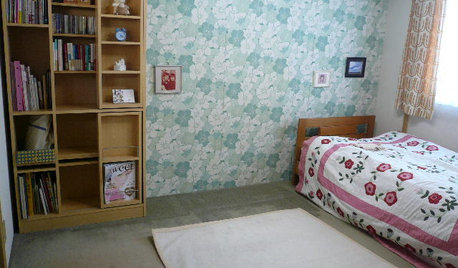







Sara Malone Zone 9b